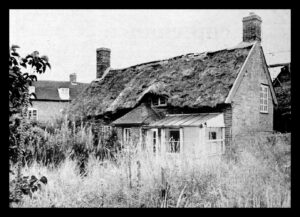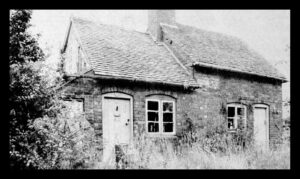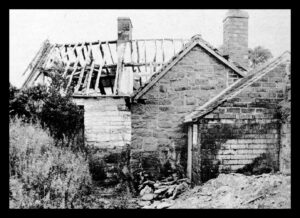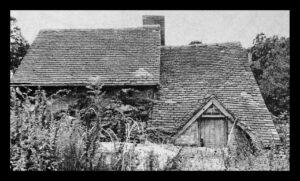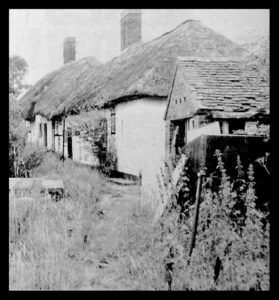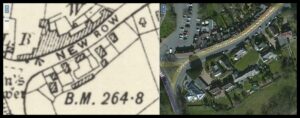Little Virginia, 12th May 2020 163/49 Likes/comments
Juie Shetye and James Smith were the first to request an article about the restoration and history of Little Virginia.
The commonly held belief that the cottages are Elizabethan in origin was dispelled by the Kenilworth History & Archaeology Society (KH&AS) who in the spring and summer of 1973 carried out the only serious investigation into the site, from which its early history can be pieced together. (The report can be seen in full in the KH&AS annual publication for 1975-76).
The society found a layer of stone chippings about a metre thick across the whole site revealing it had been in use as a mason’s yard, and perhaps a small quarry in one area, from the 13th century until the 17th; the most likely reason for the activity was in connection to either, or both, the castle and Priory, later Abbey. The conclusion drawn from their investigation is that the first cottages built on the site were those originally numbered 13-21, possibly after and in connection with the slighting of the castle in 1649; the others followed later. Also, by then the Abbey had been dissolved and thus may have provided a source of building material for the new cottages.
The cottages became part of the Earl of Clarendon’s estate, and as such were up for sale with the rest of the Abbey Fields area in 1883. They became part of the property owned by a Syndicate of Local Board members who had clubbed together to privately buy about 25 acres around the perimeter. In a very involved story, the syndicate tried unsuccessfully to sell them on, and in 1888 they ended up in the hands of one Syndicate member, George Marshall Turner, perhaps best known in town for having the clock tower built in 1906.
The cottages were already in a dilapidated condition, and by the Edwardian years were considered as suitable for demolition and redevelopment. However, there were those who also thought they were worth preserving and in stepped Lincoln Chandler of Abbotsfield who bought them in August 1914 with the intention to restore them sympathetically, just as numbers 81, 83 and 85 High Street had been a few years before.
The following year, Chandler deposited plans for re-building the cottages and work commenced, but he had to leave Kenilworth in 1918, in all probability in connection with war-work at his BSA company. All his Kenilworth property was bought by tannery owner, Charles Randall, and this ensured Little Virginia’s immediate future, and of course, ‘relieved its tenants of needless worry’; the conveyance is dated 10th October 1918.
Upon the death of Charles Randall in 1933, the cottages became owned by The Charles Randall Trust which was in the name of his two sons.
In 1968 the cottages were offered to the KUDC, but they were already listed as ‘sub-standard’ on their unfit properties register and so they declined. Despite this, on 14th May 1969, Little Virginia was included in a newly designated Conservation area, fully adopted in August 1970. It must be remembered that at this time there was much development work going on in Kenilworth, including ‘slum clearance’ and many cottages of a similar, or older, antiquity were demolished or about to be, including in Clinton Lane, School Lane, Warwick Road and Bridge Street; the latter caused locals to form the Kenilworth Society from which sprang the history society.
Such was the poor condition of the fifteen Little Virginia cottages that in 1969 the Council took it upon themselves to re-house their residents, many of them elderly, but some remained including one couple who despite having two tarpaulins on the roof still got rain-water running down their bedroom walls, and slept each night with plastic sheets at the ready. At some point the KUDC decided upon compulsory purchase of the site; one councillor was memorably quoted as saying, ‘If something isn’t done soon about Little Virginia, hooligans will reduce it to a rockery’. The Charles Randall Trust had done little work on the cottages and showed no interest in doing so, but then in October 1971 put them up for sale; the KUDC had made slow and incomplete progress with their own purchase plans.
The cottages were bought by William Sapcote &Sons, perhaps the country’s leading renovators of old buildings, who set about the building work in April 1973; it was then that the KH&AS got in touch and arranged the archaeological dig and investigation whilst the work was in progress. Great credit for this is deserved by both parties. Sapcote’s demolished one and then rebuilt the remaining 14 cottages into 10; some were substantially altered. The former numbers 5 & 7 became number 1; 9 & 11 became 2; 13 became 3; 5, 17 & 19 became 4 & 5; 27 & 29 became 6; 23 & 25 became 7; 31 became 8. Prices for purchase were from £22,500 to £26,500; their previous, elderly, residents had no chance of returning. Sapcote’s won an award for their work, and whilst in town also built the new top for the clock tower that had been damaged then removed in November 1940.
It is not possible to compose an article about Little Virginia without mentioning the word ‘potato’. In summary: there is no record of Sir Walter Raleigh visiting Kenilworth at all; he owned plenty of land and property in England and Ireland in which to grow his spuds; Little Virginia was at the time a rock strewn mason’s yard; and in any case, with more recent research it is becoming less likely that Raleigh had anything to do with potatoes coming to England anyway. But let’s assume that he did; why on earth would he have lugged a sack of his newly imported rare plant to almost the furthest possible point from the sea, to clear a rock-strewn area, and then plant them alongside a road in a place he didn’t know?
The answer is of course that he wouldn’t, but what is the origin of the story? Some of the early settlers in America returned to Britain and a Victorian historian suggested that some of them, or their descendants, were the first to live in the cottages when built, and they named it after their former home. Apparently, a couple of the names are the same, although I have yet to discover which. I don’t think we will ever know for sure.
Most of the above is extracted from my book, The Abbey Fields, in which many more details can be found.
The photographs are taken from the Kenilworth Weekly News of 17th November 1972, as Sapcote’s planning application for development was passing through the KUDC planning department.
The side-by-side map gives an indication to the alterations since 1906.
